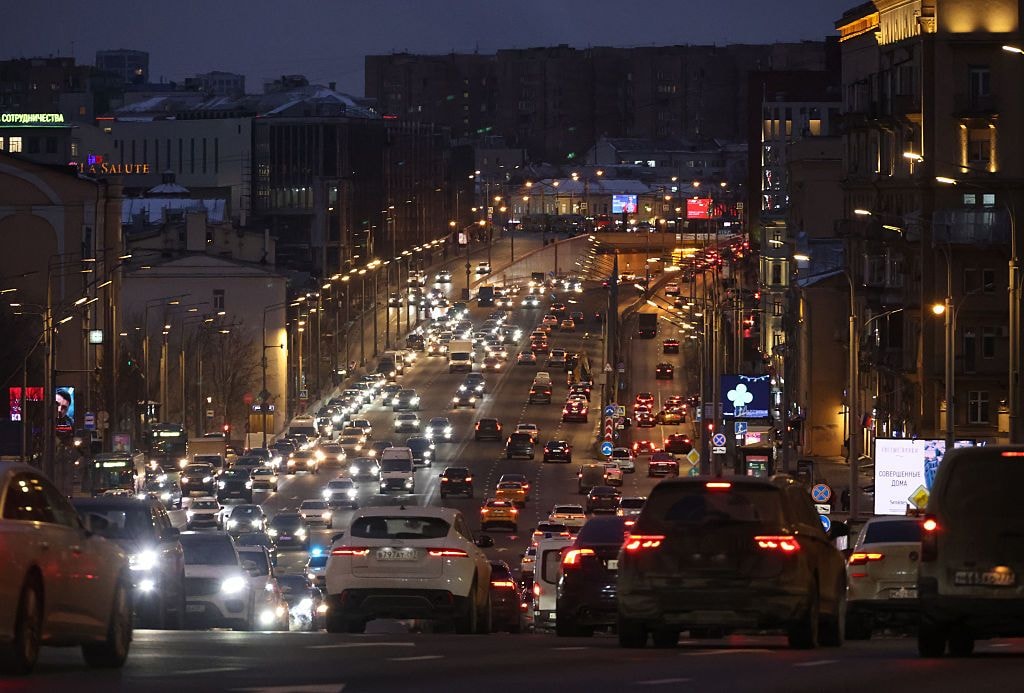Ukraine war latest: Mass attack on Kyiv injures at least 13, including child

Key developments on March 21:
- Russian missile attack on Kyiv injures at least 13, including child
- Russia continues to redeploy Black Sea Fleet from Crimea, Ukraine promises ‘new steps’ to target it
- Estonia unveils $22 million defense package
- Official: Russia fires at occupied Kherson Oblast infrastructure in 'provocation' act, causes outages
- Russian media: Krasnodar Krai to close 2 prisons after inmates leave to fight in Ukraine
Russian forces launched dozens of missiles towards Kyiv early in the morning of March 21, injuring at least 13 people and causing damage to homes and infrastructure throughout the city.
According to Kyiv Mayor Vitalii Klitschko, at least two people were hospitalized. Serhii Popko, head of the Kyiv City Military Administration, said one of the Shevchenkivskyi district victims was an 11-year-old girl.
The attack damaged apartment buildings, a kindergarten, a business, infrastructure, and vehicles. Emergency services are working at the attack sites, and the full extent of the damage is being investigated amid ongoing attacks.
The Air Force reported that Russian forces launched two ballistic missiles, as well as 29 Kh-101/Kh-555 cruise missiles from the Volgodonsk area in Rostov Oblast and Saratov Oblast's Engels. All 31 missiles were downed by Ukraine's air defense.
A series of explosions occurred in the capital around 5 a.m., Klitschko said. Kyiv Independent correspondents reported hearing over a dozen in the city.
Falling rock fragments in the Podilskyi district caused a fire to break out at a transformer substation and at a two-story non-residential building, Klitschko reported.
A residential building in the Shevchenkivskyi district was also hit, Klitschko said, and residents were evacuated from the burning building.
A warehouse of the online retailer Rozetka was damaged while 99 employees were on the shift, said Vladyslav Chechotkin, the company's representative. While the building, cars, and goods suffered heavy damage, no staff members were hurt as they were in a shelter during the attack.
Missile fragments also hit civilian areas elsewhere in Kyiv Oblast, damaging houses and injuring two people, the regional prosecutor's office said.
Russia continues to redeploy Black Sea Fleet from Crimea, Ukraine promises ‘new steps’ to target it
Russia is continuing the redeployment of its Black Sea Fleet from occupied Crimea to the relative safety of Novorossiysk after yet more successful strikes on its ships, Ukraine’s military intelligence (HUR) reported on March 21.
Speaking on national television, HUR spokesperson Andrii Yusov said Black Sea Fleet headquarters infrastructure and warships “are being actively relocated.”
“The redeployment to Novorossiysk continues, although they cannot completely leave occupied Crimea without naval forces as such,” he said, adding: “Otherwise, that would mean fleeing.”
Russia began the redeployment of the Black Sea Fleet last year after a series of devastating Ukrainian strikes including a missile attack on its headquarters in Sevastopol on Sept. 22.
Satellite imagery from Oct. 1 and Oct. 3 showed Russia had moved at least 10 vessels, including the frigates Admiral Makarov and Admiral Essen, from Sevastopol to Novorossiysk, located on the Russian coast and out of range of weapons like the Storm Shadow missiles.
But in the months since, the fleet has continued to lose ships in the Black Sea, most recently the Sergey Kotov patrol ship which was hit and sunk by Ukraine’s domestically-produced Magura V5 naval drones.
The Strategic Communications Center of the Armed Forces of Ukraine (StratCom) recently reported that as of early February 2024, 33% of the fleet’s warships had been disabled including 24 ships and one submarine.
Russia has taken a number of steps to address the continuing threat, including replacing the commander of the Russian Navy earlier this month.
On March 17, Russian Defense Minister Sergei Shoigu on a visit to Sevastopol said Black Sea Fleet ships would be armed with heavy-caliber machine guns to help destroy Ukrainian sea drones.
Referencing Russia’s new push to protect its ships, Yusov said that Ukraine’s future attacks will not necessarily be a repetition of previous operations.
“These will be new combined steps in the air, at sea, and on land.”
Estonia unveils $22 million defense package
Estonian Defense Minister Hanno Pevkur announced a defense aid package for Ukraine worth 20 million euros ($22 million) during his visit to Kyiv on March 21, the Estonian Defense Ministry announced.
"The package includes recoilless anti-tank guns, explosives, various types of artillery ammunition, gas masks, sniper equipment, smaller caliber ammunition, and more," Pevkur said.
Artillery shells are a crucial capability for Ukraine as the country faces critical ammunition shortages, namely due to delays in U.S. assistance.
"We put this package together, focusing on providing the maximum benefit to Ukraine while making sure not to diminish Estonian defense readiness," the Estonian defense minister said.
The tranche includes 155 mm shells, donated as Tallinn's contribution to the EU's plan to supply Kyiv with 1 million rounds. Their exact number is confidential. According to the Estonian Defense Ministry, Denmark will partially finance the replenishment of this donation.
The EU failed on its promise to deliver 1 million artillery shells between March 2023 and 2024. After supplying only about half of the promised rounds, Brussels shifted the deadline to the end of this year.
In a separate initiative, Czechia is collecting funds for the purchase of 800,000 artillery shells for Ukraine from suppliers outside the EU.
Pevkur said that during his visit to Ukraine's capital, he met his Ukrainian counterpart, Rustem Umerov.
"The overview that Defense Minister Umerov gave us about the situation on the battlefield confirmed that this package is very much needed," Pevkur noted.
The Baltic country, with a population of 1.3 million, is one of the leading military donors to Ukraine in terms of share of gross domestic product (GDP), according to the Kiel Institute for the World Economy.
Over the next four years, Tallinn plans to allocate 0.25% of its GDP to military assistance for Kyiv. The country's previous aid included Javelin anti-tank missiles, howitzers, artillery ammunition, anti-tank mines, anti-tank grenade launchers, and more.
Official: Russia fires at occupied Kherson Oblast infrastructure in 'provocation' act, causes outages
Russian troops struck energy infrastructure in the occupied part of Kherson Oblast as a "provocation," leaving residents of the Russian-held city of Kakhovka without gas, electricity, and water supply, said Yurii Sobolevskyi, the first deputy head of the Kherson Oblast Council, on March 21.
Kakhovka is a port city located on the east bank of the Dnipro River, which was home to around 34,750 citizens before the beginning of Russia's full-scale invasion in 2022.
Russian troops have occupied Kakhovka since the all-out war started. Russian forces regularly shell Ukrainian cities and villages from the occupied part of Kherson Oblast.
Sobolevskyi called the latest Russian attack "a provocation," as Russian proxies alleged that Ukraine's Armed Forces conducted the strike.
"Ukrainian army strikes only military targets. And leaving people without the necessary living conditions – this is namely the Russian army's habit," Sobolevskyi wrote on Facebook.
After Ukraine's Armed Forces liberated Kherson and other regional settlements on the west bank in 2022, Russian troops were pushed to the river's east bank, from where they have since been firing at the liberated territories, regularly resulting in civilian deaths as well as large-scale destruction of homes and infrastructure.
As of the morning of March 21, two people were killed and four injured due to Russian attacks over the past day in Kherson Oblast. Russian troops struck 12 cities and villages, including the regional center of Kherson.
Russian media: Krasnodar Krai to close 2 prisons after inmates leave to fight in Ukraine
The number of inmates joining the Russian army has led the authorities in Krasnodar Krai to decide to close two prison colonies, Russian state media outlet Kommersant reported on March 21, citing Mark Denisov, the regional commissioner for human rights.
The lack of prisoners "prompted someone to report to the top about the need to close penitentiary institutions in order to optimize and save money," Denisov said, describing this as an "alarming trend."
Moscow has been recruiting convicts for its war since summer 2022, first under the auspices of the Wagner mercenary group and then directly under the Russian Defense Ministry.
Most of the convicted recruits serving in the Russian military were assigned to the Storm Z assault units, effectively used as cannon fodder and suffering heavy casualties.
The prisoners, even those convicted of violent crimes, were promised a pardon if they completed a six-month military contract.
Denisov said he was against the prison closures, claiming that the drop in the number of inmates was a "one-off" phenomenon and that in the future, "everything will return to normal."
According to Kommersant, one prison for first-time offenders and one prison for repeat offenders are set to be closed in Krasnodar Krai.
Mykhailo Podolyak, an advisor to the Head of the President's Office, said in January 2023 that nearly 80% of Russian prisoners recruited by Wagner had been killed, injured, or captured by Ukraine. The following month, the group claimed it had stopped recruiting prisoners.
According to the BBC, the situation in the Russian military changed in September 2023, when prisoners were given new conditions, as their contract was to be signed for a year instead of six months and would be automatically prolonged.
Instead of pardon, the prisoner recruits are released on parole, which can be changed into pardon only if they receive a military award, suffer serious injuries, reach the age limit of service, or the war ends, the BBC said.











